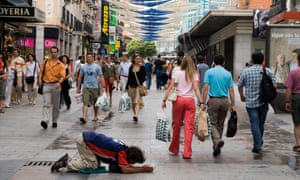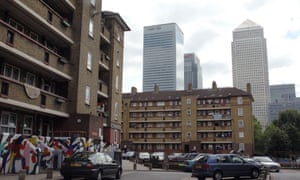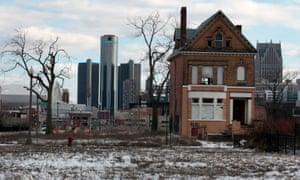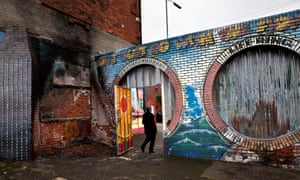
“Reclaim your community,” declared the posters. “Hipsters beware.” Pinned around London’s East End last month, they announced Fuck Parade, an anti-gentrification demonstration that culminated in an attack on a café selling bowls of cereal. Long the first port of call for cash-strapped new arrivals in the city – Irish, Jews, Bangladeshis and many others – the East End was changing, said Fuck Parade’s organisers. They explained that they were protesting against increasing economic segregation: the construction of “luxury flats that no one can afford” instead of “genuinely affordable housing”.
London certainly is a very inequitable city. The richest 10% of its residents own 60% of the city’s assets. The top 10th of London earners take home around 4.5 times as much as the bottom 10th.
However, according to new research, and unlike many European cities, between 2001 and 2011, London did not actually become more economically segregated … largely because the city was so divided to start with.
“In the central parts of London, housing is extremely expensive and segregation is already high,” says Maarten van Ham, professor of urban renewal at Delft University of Technology and the University of St Andrews. Van Ham co-authored the study, which measured a range of variables associated with segregation: income, occupational status, education and more.

The research found that, in the decade from 2001, segregation increased in 11 of 13 major European cities (the other exception, along with London, was Amsterdam.)
In Scandinavia, for example, the traditional Nordic model seems to be fraying at the edges. In Stockholm, social housing is being sold into the private sector; even in famously equal Oslo, rich and poor are increasingly living parallel lives in different parts of the city.
Across the Baltic Sea, Vilnius and Tallinn have gone from Soviet cities with limited private ownership of housing to hyper-capitalist ones in just 25 years.
Throughout Europe, inequality is on the rise. Our cities are looking and feeling very different, as middle-class professionals flock to central neighbourhoods while immigrants increasingly congregate together, often in suburban enclaves. “Without inequality, there wouldn’t be any segregation by income,” says Van Ham. “If inequality increases in a city, you expect segregation to rise, too.”
For example, the city where segregation increased the most among the 13 studied was Madrid – not due to an influx of property speculators, but rather a lack of affordable housing, which, for example, forced young people to stay living with their parents. In Vienna, the number of professionals has doubled in the past decade, squeezing out poorer residents.
In 2005, riots broke out across the Parisian banlieues. The insurrection was, in part, a protest against inequality, and yet segregation has increased in the years since.
Over the past three decades, it has increased in most US cities, too. The most extreme economic examples are concentrated in college towns – in part because the vertiginous cost of American university education attracts only the wealthiest. But it affects larger cities, too: New York, Philadelphia and Chicago are segregated along economic lines and are getting worse.
North of the border, in Winnipeg, a “great divide” has opened up between the 80,000-strong indigenous population and the rest of the city’s residents. Most of Winnipeg’s First Nations community live in the inner city and the North End, two of the poorest postcodes in Canada. On a whole host of indices, from access to housing to exposure to violent crime, aboriginals fare worse.

But for the starkest examples of segregation, we have to look beyond Europe and North America. In Ulaanbaatar, Mongolia, hundreds of thousands of erstwhile nomads live in felt-covered “ger” tents on scrubland on the outskirts of the city, while downtown, the nouveau riche shop in expensive designer stores. And in Johannesburg, walls – often topped with broken glass and surveillance cameras – separate the wealthy from the hoi polloi. The South African city, once strictly segregated along racial lines, is now divided by income.
Cities, of course, are not just divided by money. Belfast, too, has walls – in this case iron “peace walls”, some almost 20ft high, built to separate nationalists and unionists. In the Indian state of Gujarat, scene of vicious anti-Muslim riots in 2002, many Hindus and Muslims live in separate, sprawling ghettos. Parts of the Saudi Arabian capital, Riyadh, are split along gender lines, with women-only shopping centres and restaurants, and even a dedicated women’s day at the local zoo.
Indices of dissimilarity – which measure the evenness of two groups (such as ethnic or occupational) in any given area – can be used to chart segregation. According to one study, Detroit is the most racially unequal metropolis in the US, with a dissimilarity score of almost 80: a largely black inner city, with whites living predominantly in the surrounding suburbs.

And yet, racial segregation may not be inevitable in large multi-ethnic cities. In Los Angeles, for example, segregation has actually decreased, according to new research. In 2000, 40% of LA’s population lived in strongly segregated neighbourhoods; by 2010, it was one-third. The biggest fall has been in the number of heterogeneous white areas. “Diversity and heterogeneity is the new structure of urban society,” the authors conclude.
In Europe, however, cities are likely to become more divided as the impact of the 2008 financial crisis really starts to bite. “The crisis has probably caused inequality to rise in Europe,” says Van Ham. “But there is a serious time lag – five to 10 years – between rising inequality and when it affects cities.”
Compared with other cities around the world, however, Europe’s capitals are still relatively mixed. The oil-rich Angolan capital of Luanda has been, in some measures, the world’s most expensive city for each of the last three years. The super-rich live in gated, high-rise apartments; hotel rooms cost upwards of £250 a night for the most rudimentary. Poorer residents, meanwhile, struggle to survive in makeshift housing, unable to afford the eye-watering prices for basic staples such as milk and tomatoes.
This piece originally appeared in the Guardian.